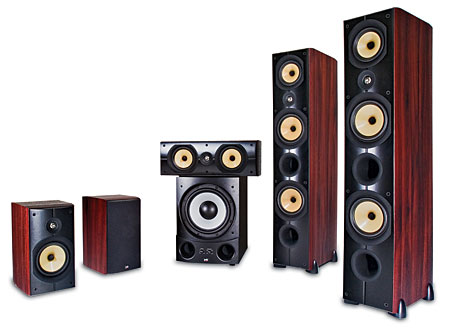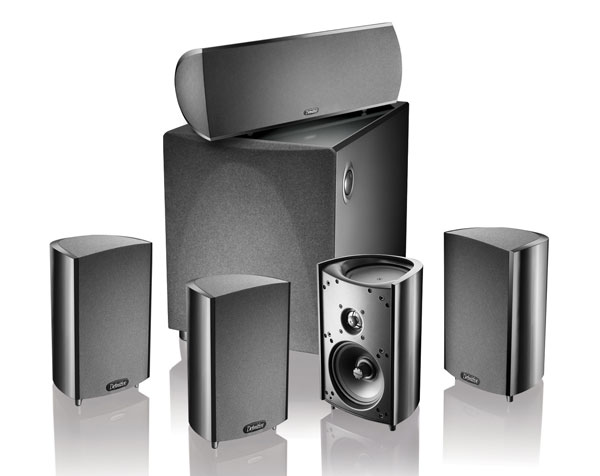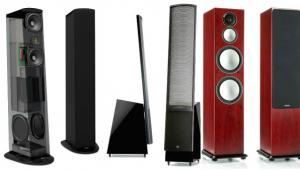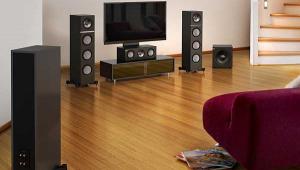Just the Facts: Speaker Shopping & Tech Tips Page 2

FLOORSTANDING VS. COMPACT SPEAKERS
- Floorstanding. Floorstanding speakers usually reach lower in the frequency range and deliver deeper bass thanks to their larger cabinet design. They’re used in the front left and right positions and may go suitably low for a satisfying experience with music, but even systems with floorstanders usually demand the assistance of a powered subwoofer for achieving the lowest and most dynamic bass effects on movie soundtracks. The primary benefit in floorstanding speakers is that the designer has full control over the transition between the bass and midrange frequencies through driver selection and crossover design, which may achieve a more balanced sound or more coherent imaging than with a compact, bass-limited speaker that’s been poorly mated with a subwoofer. Another potential benefit is the ability to play louder and therefore deliver more convincing dynamics than small, compact speakers.
- Compact Speakers. Compact speakers are naturally limited in their ability to deliver low bass frequencies because of their smaller bass drivers and the low volume of the cabinet. However, they may be less obtrusive and easier to place, and they will likely be less costly than floorstanding speakers of similar quality. When properly mated with a well-placed and well-adjusted subwoofer so there is no sonic gap between them, better compact speakers can deliver an experience that is as satisfying as that from floorstanding speakers. When using compact speakers in the front left and right locations, we typically recommend using speaker stands rather than placing them directly on a shelf or in a cabinet to avoid undesirable interactions with the furniture and allow some adjustment of position.

IN-WALL/ON-WALL SPEAKERS
- In-Wall. Mounted directly in the wall and all but the best use the wall cavity as a cabinet. Better ones include a back box or enclosure to optimize performance and keep the wall from transmitting sound to adjoining rooms. More often then not, in-wall speakers involve a compromise in performance vs. freestanding speakers, but there are some very high performance models available for those willing to invest.
- On-Wall.Typically have shallow enclosures and sound their best mounted directly against the wall. Like in-wall speakers, they tend to deliver relatively little deep bass and benefit from or require a subwoofer elsewhere in the room.
A soundbar reproduces anywhere from two to seven channels of sound from a convenient, single-cabinet speaker placed directly above or below the screen. Due to the small size of their drivers and the typically small and shallow volume of their cabinets, virtually all soundbars require a powered subwoofer to satisfyingly reproduce low frequencies. There are four basic types of soundbars:

- Passive LCR. Accepts the left, center, and right channel signals from an A/V receiver, with the intent of replacing the separate front three speakers of a typical theater system.
- Passive Multichannel. Accepts signals from all five (or seven) of an A/V receiver’s main channels, and includes drivers and/or technology to create “virtual” surround sound. Most soundbars benefit from an additional subwoofer to reproduce low frequencies.
- Active LCR/LR. LCR type includes signal processing, amplification, and drivers for the left, right, and center channels of a home theater system. A variation is the active LR system, wherein the dedicated center channel drivers are omitted. Sometimes these systems contain technology to artificially widen the soundstage to create an illusion of spaciousness or surround sound, though the goal is generally understood to be providing a more robust two-channel stereo alternative to a TV’s built-in speakers.
- Active Multichannel. All-in-one solution that contains its own processing and includes drivers and/or technology to create “virtual” surround sound.
When auditioning speakers, bring content you’re intimately familiar with, and listen for:
- Frequency Balance.Don’t ignore the midrange in favor of splashy highs and powerful lows, which will leave you with a sizzle-and-boom system. The most important stuff lies in the middle, where your hearing acuity is concentrated. Is the midrange peaky or recessed? Do voices sound natural, or do they sound nasal, congested, shrill, tubby, or veiled? Is dialogue consistently intelligible?
- Soundstage. Good speakers—even in just a stereo pair—can produce a convincing left-to-right soundstage, and should muster convincing front-to-back depth. Surround sound should add more depth, creating a soundfield that feels wide and deep and extending somewhat beyond the outer limits of the speakers. If the panning of sounds left to right or front to back seems uneven, the speakers are not well matched, their levels have not been balanced, or they are not correctly positioned.
- Dyanmics.The best speakers (mated with the best source material and amplification) will cleanly track the music as it goes from the quietest passages to the loudest and most complex, and clearly articulate at all volume levels. The wider the dynamics, the better. When a good amp drives good speakers, the sound doesn’t compress or break up at powerful peak moments. Great speakers are equally adept at low-level resolution. They make a whisper audible and generate a palpable soundfield, even at low volumes.
- Trust your instincts. Listening involves feeling. Trust your instincts. They may be a step or two ahead of what you’re consciously thinking. Watch out for fatigue and boredom. Either one can be a serious warning sign.
See our Guide to Speakers for more detailed information on selecting speakers. Also read Sound & Vision speaker reviews for expert opinions on how speaker systems perform. Happy shopping!











































